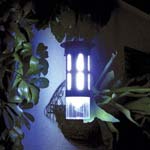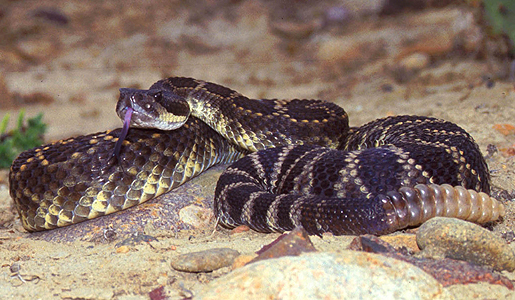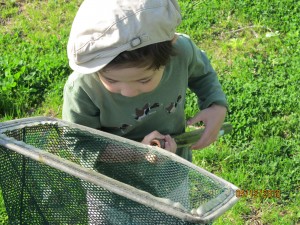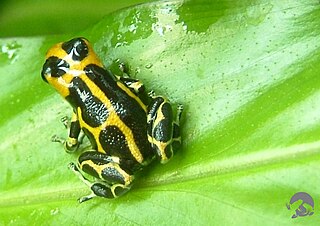I’ve spent decades working with venomous snakes, setting-up snakebite protocols in zoos, and responding to snakebite emergencies. Today, I’m sometimes criticized for my strong stand against the keeping venomous snakes in private collections. But I have learned that, even under the best of circumstances, treatment can be hampered by gaps in our knowledge. For example, we know that the chemical characteristics of venom vary over the ranges of certain species. This can affect treatment, and, as we’ll see below, may mean the difference between life and death for a victim. In fact, the venom of some Southern Pacific Rattlesnakes is so unique that it is unaffected by the antivenin currently in use! Are they the most dangerous snake in the USA?
What Do Leopard Geckos Eat? – An Ideal Diet Based on Zoo Research
What DO Leopard Geckos Eat?! The Leopard Gecko, Eublepharis macularius, makes a wonderful pet for novices and advanced hobbyists alike (even after many years as a professional zookeeper, I enjoy keeping them, and wrote a book about their care). However, both sellers and buyers sometimes underestimate this delightful lizard’s needs, especially where feeding is concerned. Contrary to popular belief, vitamin-powdered crickets and mealworms do not constitute a suitable diet! If you wish your pet to live out its potential lifespan of 20-30 years in excellent health, you’ll need to provide it with as many different foods as possible. Fortunately, a surprising array of insects can be purchased online and in stores. Collecting and rearing your own insects is another excellent way to add to your gecko’s quality of life…and its great fun as well! Read More »
2014 is Named “The Year of the Salamander”
Salamanders and newts, often overlooked by pet keepers, zoos and environmentalists alike, are getting some much-needed exposure this year. Led by the Partnership for Amphibian and Reptile Conservation, a consortium of environmental groups has designated 2014 as the Year of the Salamander. I’m very pleased, as past efforts, including the Year of the Snake and the Year of the Lizard, have done much to advance reptile conservation.
Even among my Bronx Zoo colleagues, I was considered somewhat strange when I began writing a book on newt and salamander natural history and captive care some 17 years ago. But I have been very lucky, salamander-wise. Perhaps because so few people were interested, many fascinating opportunities came my way. Whether crossing the USA and Japan in search of my favorite species or caring for those in my home collection – several of which are now aged 25 to 35 – I’ve never tired of learning about them, and remain as passionate today as I was in childhood.
Salamander Central
Salamander enthusiasts based in the USA are quite fortunate, as more species live here than anywhere else on earth. In fact, the southern Appalachian Mountains, a salamander hotspot, are home to 10% of the world’s known species. And the sheer diversity of their sizes, lifestyles and behaviors is beyond belief – colorless cave-dwellers that never see the light of day, yard-long eel-like species armed with sharp teeth, tiny lichen-colored rock dwellers, colorful beauties, terrestrial giants large enough to raid mouse nests and so many more.
My zoo-keeper and hobbyist friends in other countries are astounded that those living in the epicenter of salamander diversity do not devote more of our efforts to these amazing creatures. I’ve written about some of our species in other articles…please post below and I’ll send links.
Year of the Salamander Activities
The Year of the Salamander effort is spearheaded by Partners in Amphibian and Reptile Conservation (PARC), and was preceded the Year of the Turtle, Snake and Lizard. This year, PARC will be joined by the Center for Conservation Biology, the Association of Reptile and Amphibian Veterinarians, Amphibian Ark, and other notables. In addition to field research and captive breeding programs, public education will be a major component of each group’s activities.
I’m happy to see that input from interested non-professionals will be solicited. This is an all-too-rare step, despite the fact that professionals with financial resources cannot begin to address the conservation needs of the world’s threatened amphibians.
Salamander Populations Plummeting Worldwide
Frog extinctions have been very much in the spotlight in recent years. Fueled by emerging diseases (please see below) that have exacerbated the threats posed by habitat loss and other long-standing concerns, frog declines have been documented around the globe.
Salamanders, which are usually harder to find and study (after all, none advertise their presence by croaking!), are likely in just as much trouble as frogs. In fact, the IUCN classifies 49.8% of the world’s salamanders as threatened or endangered, as compared to 31.6% of the world’s frogs! Considering that salamanders are so poorly studied, the conservation picture could actually be far bleaker than the IUCN’s frightening statistics indicate. Hopefully, the Year of the Salamander effort will divert much needed interest and funds to salamander conservation.
Specific Threats
The future of the world’s salamanders and newts is put in jeopardy by many of the same problems that afflict frogs – habitat loss, road mortality during the breeding season, pollution, invasive species (especially fish) and others. Unique threats also exist – for example, Tiger Salamanders, classified as endangered in some US states, are legally used as fish bait in others (please see article below)!
While the devastating effects of Chytrid and Ranavirus infections on frog populations are well known, related salamander studies are in short supply. However, in 2013, a new strain of Chytrid was found to be killing Fire Salamanders in Europe…I fear that this is merely the tip of the iceberg.
Help and Input Needed
Please check out my salamander conservation articles, some of which are linked below, and share your thoughts and observations by posting in the comments section of this article. A book I’ve written, which addresses both natural history and captive care, may also be useful to those interested in helping these amazing amphibians.
Further Reading
Salamander larvae Still Being Used as Fish Bait in the USA
New Population of Endangered Axolotls Found…in Mexico City!
Twelve Rare US Amphibians in Need of Protection
Collecting Insects as Reptile and Amphibian Food – Traps and Tips
 Although it’s below freezing here in NY, my thoughts are straying to a favorite warm-weather activity – collecting insects for my herp collection. Invariably, I find species that are new to me, and others that I wind up keeping alive in small terrariums. Drawing on a lifetime of collecting for my pets and the animals under my care at the Bronx Zoo, I’ve written articles on capturing, using, and breeding many invertebrates, including sap beetles, leaf litter dwellers, “meadow plankton”, earwigs, sow bugs, grasshoppers, and many others. In this article, I’ll summarize my favorite collection techniques and traps. Links to articles containing further information are also included. As I and other herp-keepers have barely scratched the surface of this topic, please be sure to post your own thoughts and experiences below.
Although it’s below freezing here in NY, my thoughts are straying to a favorite warm-weather activity – collecting insects for my herp collection. Invariably, I find species that are new to me, and others that I wind up keeping alive in small terrariums. Drawing on a lifetime of collecting for my pets and the animals under my care at the Bronx Zoo, I’ve written articles on capturing, using, and breeding many invertebrates, including sap beetles, leaf litter dwellers, “meadow plankton”, earwigs, sow bugs, grasshoppers, and many others. In this article, I’ll summarize my favorite collection techniques and traps. Links to articles containing further information are also included. As I and other herp-keepers have barely scratched the surface of this topic, please be sure to post your own thoughts and experiences below.
The Best Method, Bar None
The best collecting tip I can provide is that you team up with a small child. As you can see from my photos, their enthusiasm cannot be out into words, and it is contagious. What’s more, a child’s curiosity, size and sharp eyesight will increase your catch – and your enjoyment of the experience – immensely. My little collecting partner has found invertebrates that I’ve never seen before, even in areas I’ve explored for decades!
 The Zoo Med Bug Napper Insect Trap
The Zoo Med Bug Napper Insect Trap
The Zoo Med Bug Napper is a scaled-down version of the traps I used to collect food for the Bronx Zoo’s reptiles, amphibians, and birds. It is very effective at snaring moths, beetles, midges, and other flying insects. Along with field sweeping (see below), this trap has the potential to yield the greatest numbers and varieties of insects. Checking it each morning is a thrilling experience, and finding a species new to you – or even to science – is a real possibility.
This term is used by entomologists to describe the astonishing variety of invertebrates that can be collected by simply sweeping a net through tall grass. The accompanying photo was taken after collecting in a tiny, overgrown field in the middle of a busy park. Twenty minutes of “work” yielded 30-40 species, including spiders, leafhoppers, aphids, grasshoppers, mantids, bee flies, caterpillars and many others…and my nephew later spent hours poring over his books trying to identify our prizes.
Leaf Litter Invertebrates
A single acre of fallen leaves can be home to 3 tons (yes, tons!) of springtails, ants, beetles, spiders, millipedes and other invertebrates. Many are tiny, and readily accepted by Poison Frogs and other small herps that must generally make do with only 2-3 food items.
To sample what’s out there, simply place a handful of leaf litter into a funnel, suspend the funnel over a jar and position a 100 watt bulb about 6 inches above the leaves. Creatures seeking to escape the heat will move down the funnel and into the jar. A damp paper towel placed at the bottom of the collecting jar will assure they survive until removed. More information.
Termites feature heavily in the diets of animals ranging from tiny toads to huge monitor lizards. To make a termite trap, simply take a small plastic storage box and cut several holes of 2-3 inches in diameter into the 4 sides. Stuff the box with damp cardboard (a termite delicacy, it seems) and you’re all set. Search for termite nests beneath rotting logs, and place your trap about a foot away, buried so that the top of the box is flush with the surface. The termites will establish feeding tunnels to the box, and can be removed as needed (leave the box in place so as not to disturb the tunnels). More information.
Pitfall Traps
A bewildering assortment of creatures will stumble into a jar or can buried flush with the ground, but you can increase your catch by adding bait. A bit of ripe fruit, molasses, honey and some tropical fish flakes will lure beetles, snails, sow bugs and other invertebrates. Be sure to keep some dead leaves in the trap to provide hiding places, and cover the opening with a board that is slightly elevated by small stones, to keep out rain. More information.
Bush Beating
This simple yet effective collecting technique was developed by entomologists. To collect insects in this manner, place a white, un-patterned sheet below a bush or tree, and beat the foliage with a stick. That’s it!
For me, the biggest drawback to bush beating is the distraction factor – I just can’t resist closely checking the incredible assortment of caterpillars, beetles, ants, tree crickets, katydids, spiders and other tasty morsels that rain down. Your catch will consist largely of arboreal species, which are especially-relished by tree frogs, flying and day geckos, smooth green snakes and other tree-dwelling herps. More information.
Random Searching
By keeping a jar and net in my yard and near outdoor lights, I can easily add variety to my pets’ diets by collecting as time permits. I also turn over rocks, look among flowers and weeds, scatter cover boards about, smear honey on trees and try anything else that comes to mind – some invertebrate will show up.
To explore other possibilities, please see my articles on collecting sap beetles, earwigs, sow bugs, grasshoppers, houseflies, mantis egg cases, cicadas and aquatic isopods.
Cautions
Be careful when examining your catch, as potentially dangerous (to you and your pets) spiders, scorpions, hornets and other such creatures may be present. Have a good field guide on hand if you are unfamiliar with local species, and use feeding tongs to handle animals if in doubt.
Do not use fireflies, “hairy” caterpillars, or any brightly-colored insects that you cannot identify. Unless you are well-acquainted with local spiders, it is best to avoid them as well…harvestmen, or “daddy long-legs”, however, are harmless (and judging by my pets’ reactions, quite tasty!).
Please also see the articles linked below for information concerning possible pesticides and parasites.
Further Reading
Collecting Insects for Reptile Food: Pesticide Concerns
Wild Caught Insects as Herp Food: Dangerous Species
The Most Astonishing and Bizarre Newly-Discovered Frogs
Be it the discovery of a new species in the middle of NYC or the revelation that Mimic Poison Frogs are monogamous, frog enthusiasts are accustomed to surprises. But those revealed in the last few years have been especially interesting and unexpected…frogs with sheathed claws, tadpoles that feed upon their father’s skin and on tree bark, bird-eating, bird-voiced and lungless frogs, fanged tadpoles and much, much more. Were I new to this field, I’d consider much of the following article as pure fantasy…but even after a lifetime of working with amphibians, I’m still shaking my head.
Note: please see the linked articles for further information on the frogs introduced here.
 That Reptile Blog – Reptile, Amphibian and Exotic Pet Care and Information
That Reptile Blog – Reptile, Amphibian and Exotic Pet Care and Information








